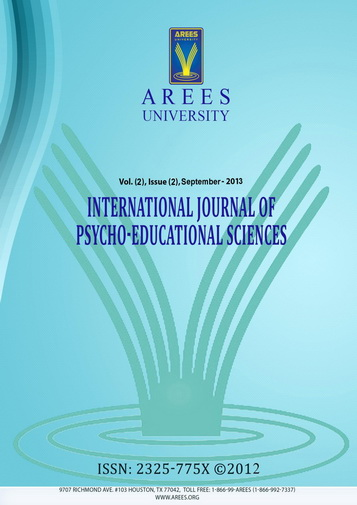What are the Effects of Students’ Preferences on Choosing Religious and other Schools in Turkey?
Keywords:
Islamic high school, Imam Hatip, Vocational School, Islamic piety, religion tendencyAbstract
In this study the differences between students who preferred to study in Islamic high schools (Imam Hatip) and other high schools in terms of the following issues were examined: a) whether or not students were religious b) whether or not students’ parents were religious c) whether or not parents lived in rural areas or in the city d) parents’ income level e) students’ basic education (grades 1-8) academic achievement f) gender. The study group comprised 500 high school students: 322 students studying at Islamic high schools (Imam Hatip), and 178 students studying at other high schools. Quest Religious Orientation Scale and Islamic Religious Affinity Evaluation Scale were used to collect data. The findings showed that Islamic high school (Imam Hatip) students had more affinities towards religion. It was also found that the parents of the majority of Islamic high school (Imam Hatip) students lived in rural areas. These students had the tendencies in having dogmatic beliefs instead of questioning and improving their way of looking at religion. Especially students who preferred Islamic high schools (Imam Hatip) were found to be low academic achievers in basic education. It was also found that male students had more religious affinities compared to female students. The latest regulations by HEC (Higher Education Council) to decrease students’ interests for Islamic high schools (Imam Hatip) did not only seriously affect students who preferred these highs schools but also students who preferred to go to other high schools. It also decreases the ratio of vocational and technical education institutions which perform educational processes effectively in the 21st century.Downloads
References
Batson, C. D., & Schoenrade, P. (1991a). Measuring religion as quest: (1) Validity concerns. Journal for the Scientific Study of Religion, 30, 416–429.
Batson, C. D., & Schoenrade, P. (1991b). Measuring religion as quest: (2) Reliability concerns. Journal for the Scientific Study of Religion, 30, 430–442.
Gençdoğan, B. (2005) Dini Yönelim Ölçeği ve Quest Religious Orientation Scale’nın geçerlik ve güvenirliği, (Validity and Reliability of Islamic Religious Affinity Evaluation Scale and Quest Religious Orientation Scale, Unpublished research).
Ginzberg, E. (1972) Restatement of the Theory of Occupational Choice, Vocational Guidance Quarterly, 20(3),169-176.
Karaca, F. (2000) Din psikolojisinde metot sorunu ve bir dindarlık ölçeğinin Türk toplumuna standardarizasyonu. EKEV Akademi Dergisi, 2 (4), 4,187-202. (Method Problems to Religious Psychology, EKEV Journal of Academy, 2 (4), 4,187-202)
Kuzgun, Y. (2000). Meslek Danışmanlığı, Uygulamalar Kuramlar. Nobel Yayın Dağıtım, Ankara (Occupation Counseling, Application and Theory, Nobel Publishing, Ankara)
Maltby, J., & Day, L. (1998). Amending a measure of the quest religious orientation: Applicability of the scales use among religious and non-religious persons. Personality and Individual Differences, 25, 517–522.
MONE Statistics, (2007) 2006-2007 yılı Milli Eğitim Bakanlığı İstatistikleri, MEB yayınları, Ankara. (2006-2007 years the Ministry of Education Statistics, MEB publishing, Ankara)
Naylor, M. (1986) Family Influences on Employment and Education. Overview. ERIC Digest No:56, ERIC Product (071): ERIC Digests (selected) (073) ERIC İdentifier:ED272702.
Nevil, D.D. and Super, D.E. (1986) The Salience Inventory: Theory, application, and research. Palo Alto, C.A.: Consulting Psychologist Press.
OSYM (2007) ÖSS 2007 Yükseköğretim Programları ve Kontejanları Kılavuzu. Ankara:ÖSYM Yayınları. (ÖSS High school programs and quota guide, Ankara:ÖSYM publishing)
Pişkin, M. (2002) Çocukların kariyer planlamasında ailenin rolü. 2001 yılı Aile Raporu. (Ed. İrfan Çayboylu) 245-271, Ankara: T.C. Başbakanlık Aile Araştırma Kurumu Yayınları. ( Role of Family to children’ carrier plans, Family report of 2001 year, (Ed. İrfan Çayboylu) 245-271, Ankara: T.R. Institution Family Research of Prime Ministry)
Pişkin, M. (2007) İlk ve ortaöğretim öğrencilerimizin kariyer gelişimleri ve yönlendirme süreçlerinde gözlenen sorunlar ve çözüm önerileri. 2006 yılı Türk Eğitim Sisteminde Yeni Paradigma Arayışları Sempozyumu. 55-97, Ankara: Pozitif Matbaacılık. (Problems and solution suggestions in process of carrier developing of elementary and junior high school students. New Paradigm Searchs in Turk Education System Symposium, 55-97, Ankara: Pozitif Press)
Robberts, S. (2002) Parents. University of Minesota, Counseling and Career Services. http://www.crk.umn.edu/people/services/CAREER/parents.html
Shaw, A., & Joseph, S. (2004) Principal components analysis of Maltby and Day’s (1998) amended quest religious orientation scale: a replication of the three component structure, Personality and Individual Differences, 37, 1425–1430.
Sharf, R.S. (2001) Applying Career Development Theory to Counseling. Brook/Coole Publishing Company, Pacific Grove, California.
Splete, H. and Freeman-George, A. (1985) Family Influences on the Career Development of Young Adults. Journal of Career Development, 12,1,55-64.
Super, D.E. (1990) A life-span, life-space approach to career development. San Fransisco: Josey-Bass.
Additional Files
Published
How to Cite
Issue
Section
License

This work is licensed under a Creative Commons Attribution-NonCommercial-NoDerivatives 4.0 International License.










